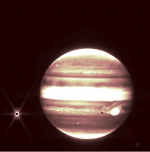thanks for the info.Sure it could be aimed at them, but those I'm sure would be considered pretty low value targets for one thing, far as I know they've been photographed in satellite flybys and shown not to be what some people thought, or hoped, they were. The so-called face on Mars, for instance, imaged at low resolution by the Viking 1 Orbiter in 1976, was seen in later higher resolution images to be a natural land form. For another thing, objects within the solar system move fast enough to make them hard to track for something as sensitive as the JWSP. Its field of view is very narrow, I doubt it can be rotated quickly enough to keep such things in the field, it wasn't designed for such nearby targets.
Space Thread
- Thread starter B00Mer
- Start date
You are using an out of date browser. It may not display this or other websites correctly.
You should upgrade or use an alternative browser.
You should upgrade or use an alternative browser.
NASA's new telescope shows star death, dancing galaxies
Author of the article:Associated Press
Associated Press
Seth Borenstein
Publishing date:Jul 12, 2022 • 16 hours ago • 2 minute read • Join the conversation
Stephan’s Quintet, a collection of five galaxies, as seen by MIRI from NASA's James Webb Space Telescope, a revolutionary apparatus designed to peer through the cosmos to the dawn of the universe and released July 12, 2022.
Stephan’s Quintet, a collection of five galaxies, as seen by MIRI from NASA's James Webb Space Telescope, a revolutionary apparatus designed to peer through the cosmos to the dawn of the universe and released July 12, 2022. PHOTO BY NASA, ESA, CSA, STSCI, WEBB ERO PRODUCTION TEAM /Handout via REUTERS
GREENBELT, Md. — NASA on Tuesday unveiled a new batch of images from its new powerful space telescope, including a foamy blue and orange shot of a dying star.
The first image from the $10 billion James Webb Space Telescope was released Monday at the White House — a jumble of distant galaxies that went deeper into the cosmos than humanity has ever seen.
The four additional photos released Tuesday included more cosmic beauty shots.
With one exception, the latest images showed parts of the universe seen by other telescopes. But Webb’s sheer power, distant location off Earth and use of the infrared light spectrum showed them in new light.
“Every image is a new discovery and each will give humanity a view of the humanity that we’ve never seen before,” NASA Administrator Bill Nelson said Tuesday, rhapsodizing over images showing “the formation of stars, devouring black holes.”
Webb’s use of the infrared light spectrum allows the telescope to see through the cosmic dust and “see light from faraway light from the corners of the universe,” he said.
“We’ve really changed the understanding of our universe,” said European Space Agency director general Josef Aschbacher.
The European and Canadian space agencies joined NASA in building the powerful telescope.
On tap Tuesday:
— Southern Ring Nebula, which is sometimes called “eight-burst.” About 2,500 light-years away, it shows an expanding cloud of gas surrounding a dying star. A light-year is 5.8 trillion miles.
— Carina Nebula, one of the bright stellar nurseries in the sky, about 7,600 light-years away.
— Five galaxies in a cosmic dance, 290 million light-years away. Stephan’s Quintet was first seen 225 years ago in the constellation Pegasus.
— A blueish giant planet called WASP-96b. It’s about the size of Saturn and is 1,150 light-years away. A gas planet, it’s not a candidate for life elsewhere but a key target for astronomers.
The images were released one-by-one at an event at NASA’s Goddard Space Center that included cheerleaders with pompoms the color of the telescope’s golden mirrors.
The world’s biggest and most powerful space telescope rocketed away last December from French Guiana in South America. It reached its lookout point 1 million miles (1.6 million kilometers) from Earth in January. Then the lengthy process began to align the mirrors, get the infrared detectors cold enough to operate and calibrate the science instruments, all protected by a sunshade the size of a tennis court that keeps the telescope cool.
Webb is considered the successor to the highly successful, but aging Hubble Space Telescope.

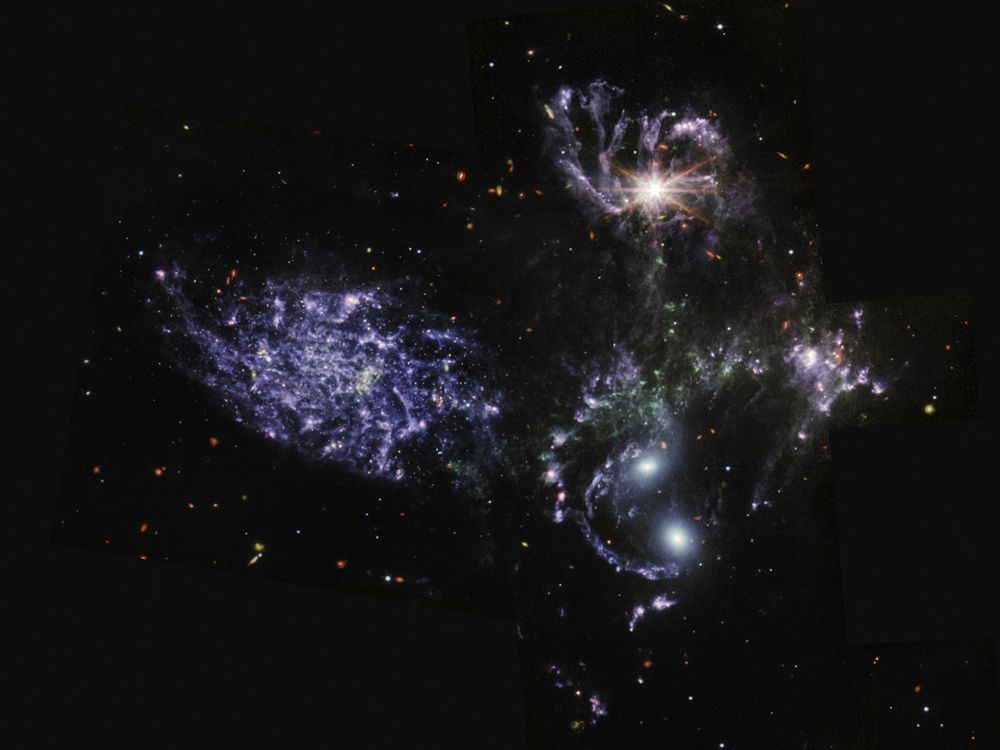
 torontosun.com
torontosun.com
Author of the article:Associated Press
Associated Press
Seth Borenstein
Publishing date:Jul 12, 2022 • 16 hours ago • 2 minute read • Join the conversation
Stephan’s Quintet, a collection of five galaxies, as seen by MIRI from NASA's James Webb Space Telescope, a revolutionary apparatus designed to peer through the cosmos to the dawn of the universe and released July 12, 2022.
Stephan’s Quintet, a collection of five galaxies, as seen by MIRI from NASA's James Webb Space Telescope, a revolutionary apparatus designed to peer through the cosmos to the dawn of the universe and released July 12, 2022. PHOTO BY NASA, ESA, CSA, STSCI, WEBB ERO PRODUCTION TEAM /Handout via REUTERS
GREENBELT, Md. — NASA on Tuesday unveiled a new batch of images from its new powerful space telescope, including a foamy blue and orange shot of a dying star.
The first image from the $10 billion James Webb Space Telescope was released Monday at the White House — a jumble of distant galaxies that went deeper into the cosmos than humanity has ever seen.
The four additional photos released Tuesday included more cosmic beauty shots.
With one exception, the latest images showed parts of the universe seen by other telescopes. But Webb’s sheer power, distant location off Earth and use of the infrared light spectrum showed them in new light.
“Every image is a new discovery and each will give humanity a view of the humanity that we’ve never seen before,” NASA Administrator Bill Nelson said Tuesday, rhapsodizing over images showing “the formation of stars, devouring black holes.”
Webb’s use of the infrared light spectrum allows the telescope to see through the cosmic dust and “see light from faraway light from the corners of the universe,” he said.
“We’ve really changed the understanding of our universe,” said European Space Agency director general Josef Aschbacher.
The European and Canadian space agencies joined NASA in building the powerful telescope.
On tap Tuesday:
— Southern Ring Nebula, which is sometimes called “eight-burst.” About 2,500 light-years away, it shows an expanding cloud of gas surrounding a dying star. A light-year is 5.8 trillion miles.
— Carina Nebula, one of the bright stellar nurseries in the sky, about 7,600 light-years away.
— Five galaxies in a cosmic dance, 290 million light-years away. Stephan’s Quintet was first seen 225 years ago in the constellation Pegasus.
— A blueish giant planet called WASP-96b. It’s about the size of Saturn and is 1,150 light-years away. A gas planet, it’s not a candidate for life elsewhere but a key target for astronomers.
The images were released one-by-one at an event at NASA’s Goddard Space Center that included cheerleaders with pompoms the color of the telescope’s golden mirrors.
The world’s biggest and most powerful space telescope rocketed away last December from French Guiana in South America. It reached its lookout point 1 million miles (1.6 million kilometers) from Earth in January. Then the lengthy process began to align the mirrors, get the infrared detectors cold enough to operate and calibrate the science instruments, all protected by a sunshade the size of a tennis court that keeps the telescope cool.
Webb is considered the successor to the highly successful, but aging Hubble Space Telescope.


NASA's new telescope shows star death, dancing galaxies
GREENBELT, Md. — NASA on Tuesday unveiled a new batch of images from its new powerful space telescope, including a foamy blue and orange shot of a dying star.
Why don't they just roll one of the mars rovers over and have a look at these alleged geometric structures?there are allegedly geometric structures on the moon, phobos, and mars, etc. can james webb be aimed at these things?
Here's a geometric structure that's the only evidence of intelligent life on a small planet. . .
Attachments

A giant leap for human knowledge
The James Webb Space Telescope reminds us of humanity’s boundless potential.
Why don't they just roll one of the mars rovers over and have a look at these alleged geometric structures?
Here's a geometric structure that's the only evidence of intelligent life on a small planet. . .
He just pointed out there are geometric structures on these bodies. He never mentioned intelligent life.
Blood from a stone? No. Well, how about water from asteroids?
An international space research study is looking at how to mine water from an asteroid 200 million miles away in a mission that could be a prelude to expanded human activity in the solar system.
Author of the article:Heather Rivers
Publishing date:Jul 17, 2022 • 1 day ago • 2 minute read • Join the conversation
An international space research study, which includes Western University researchers, is looking at how to mine water from an asteroid 200 million miles away in a mission that could be a prelude to expanded human activity in the solar system.
The Western team, partnering with other universities and MDA, a Brampton space technology company, is looking at the feasibility of asteroid mining in space and the emerging policy law about it, zeroing in on the Bennu asteroid, according to Ariyaan Talukder, a second- year mechanical engineering student at Western.
“On Earth, we have a limited amount of resources, but on asteroids there are many rare resources,” Talukder said, adding there is around $330 trillion worth of water on Bennu.
Talukder is in charge of designing an anchor to secure a drilling unit to the asteroid and a device to grip boulders, a complex task given NASA’s recent discovery that the surface of Bennu is akin to a plastic ball pit.
The discovery was found on footage taken from NASA’s OSIRIS-REx mission to the asteroid in 2020.
Discovered in 1999, the half-mile-long asteroid is considered potentially hazardous to Earth, with a chance of colliding with the planet centuries from now.
Comprised of about 10 per cent water, potential uses include powering satellites, irrigating space agriculture, as well as a propellant for rockets, he said.
Talukder said their research has concluded the colour of boulders on Bennu is meaningful.
“We’ve been able to identify that the bright boulders actually have more water content in them and we’ve been trying to map out the best locations to land and pick up those light-coloured boulders,” he said. “We are trying to find our best location to land.”
The first months of research was devoted to “heavy research on technologies we could use to get there to mine and come back,” Talukder said.
To date, they have presented some of their research from what is called the Khepri Asteroid Mining Mission at Canadian Space Agency Exploration workshop, he said.
The team, which includes faculty and students from Western’s engineering, Earth sciences and law departments, is working on its final report and will wrap up their work next month.
Talukder predicts that in the next ten years or so countries may begin tapping asteroids “to aid their economy.”
“There is a very high technical readiness that could be used in an asteroid mining mission,” he said.
A final report is expected Aug. 18 and will include models and simulations.
hrivers@postmedia.com
Twitter.com/HeatheratLFP
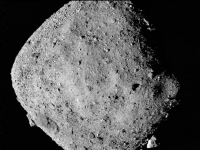

 torontosun.com
torontosun.com
An international space research study is looking at how to mine water from an asteroid 200 million miles away in a mission that could be a prelude to expanded human activity in the solar system.
Author of the article:Heather Rivers
Publishing date:Jul 17, 2022 • 1 day ago • 2 minute read • Join the conversation
An international space research study, which includes Western University researchers, is looking at how to mine water from an asteroid 200 million miles away in a mission that could be a prelude to expanded human activity in the solar system.
The Western team, partnering with other universities and MDA, a Brampton space technology company, is looking at the feasibility of asteroid mining in space and the emerging policy law about it, zeroing in on the Bennu asteroid, according to Ariyaan Talukder, a second- year mechanical engineering student at Western.
“On Earth, we have a limited amount of resources, but on asteroids there are many rare resources,” Talukder said, adding there is around $330 trillion worth of water on Bennu.
Talukder is in charge of designing an anchor to secure a drilling unit to the asteroid and a device to grip boulders, a complex task given NASA’s recent discovery that the surface of Bennu is akin to a plastic ball pit.
The discovery was found on footage taken from NASA’s OSIRIS-REx mission to the asteroid in 2020.
Discovered in 1999, the half-mile-long asteroid is considered potentially hazardous to Earth, with a chance of colliding with the planet centuries from now.
Comprised of about 10 per cent water, potential uses include powering satellites, irrigating space agriculture, as well as a propellant for rockets, he said.
Talukder said their research has concluded the colour of boulders on Bennu is meaningful.
“We’ve been able to identify that the bright boulders actually have more water content in them and we’ve been trying to map out the best locations to land and pick up those light-coloured boulders,” he said. “We are trying to find our best location to land.”
The first months of research was devoted to “heavy research on technologies we could use to get there to mine and come back,” Talukder said.
To date, they have presented some of their research from what is called the Khepri Asteroid Mining Mission at Canadian Space Agency Exploration workshop, he said.
The team, which includes faculty and students from Western’s engineering, Earth sciences and law departments, is working on its final report and will wrap up their work next month.
Talukder predicts that in the next ten years or so countries may begin tapping asteroids “to aid their economy.”
“There is a very high technical readiness that could be used in an asteroid mining mission,” he said.
A final report is expected Aug. 18 and will include models and simulations.
hrivers@postmedia.com
Twitter.com/HeatheratLFP


Blood from a stone? No. Well, how about water from asteroids?
An international space research study, which includes Western University researchers, is looking at how to mine water from an asteroid 200 million miles away in a m…
Exotic black hole deemed a 'needle in a haystack'
Author of the article:Reuters
Reuters
Will Dunham
Publishing date:Jul 18, 2022 • 15 hours ago • 3 minute read • Join the conversation
An artist's impression showing what the binary star system VFTS 243 - containing a black hole and a large luminous star orbiting each other - might look like if we were observing it up close is seen in this undated handout image. The system, which is located in the Tarantula Nebula in the Large Magellanic Cloud galaxy, is composed of a hot, blue star with 25 times the sun's mass and a black hole, which is at least nine times the mass of the sun.
An artist's impression showing what the binary star system VFTS 243 - containing a black hole and a large luminous star orbiting each other - might look like if we were observing it up close is seen in this undated handout image. The system, which is located in the Tarantula Nebula in the Large Magellanic Cloud galaxy, is composed of a hot, blue star with 25 times the sun's mass and a black hole, which is at least nine times the mass of the sun. PHOTO BY ESO/L. CALCADA /Handout via REUTERS
WASHINGTON — Astronomers have spotted in a galaxy adjacent to our Milky Way what they are calling a cosmic “needle in a haystack” – a black hole that not only is classified as dormant but appears to have been born without the explosion of a dying star.
Researchers said on Monday this one differs from all other known black holes in that it is “X-ray quiet” – not emitting powerful X-ray radiation indicative of gobbling up nearby material with its strong gravitational pull – and that it was not born in a stellar blast called a supernova.
Black holes are extraordinarily dense objects with gravity so intense not even light can escape.
This one, with a mass at least nine times greater than our sun, was detected in the Tarantula Nebula region of the Large Magellanic Cloud galaxy and is located about 160,000 light years from Earth. A light year is the distance light travels in a year, 9.5 trillion kilometres.
An extremely luminous and hot blue star with a mass about 25 times that of the sun orbits with this black hole in a stellar marriage. This so-called binary system is named VFTS 243. The researchers believe the companion star eventually also will become a black hole and could merge with the other one.
Dormant black holes, thought to be relatively common, are hard to detect because they interact very little with their surroundings. Numerous prior proposed candidates have been debunked with further study, including by members of the team that uncovered this one.
“The challenge is finding those objects,” said Tomer Shenar, a research fellow in astronomy at Amsterdam University, lead author of the study published in the journal Nature Astronomy. “We identified a needle in a haystack.”
“It’s the first object of its kind discovered after astronomers have been searching for decades,” said astronomer and study co-author Kareem El-Badry of the Harvard & Smithsonian Center for Astrophysics.
The researchers used six years of observations from the European Southern Observatory’s Chile-based Very Large Telescope.
There are different categories of black holes. The smallest, like the newly detected one, are so-called stellar-mass black holes formed by the collapse of massive individual stars at the ends of their life cycles. There also are intermediate-mass black holes as well as the enormous supermassive black holes residing at the center of most galaxies.
“Black holes are intrinsically dark objects. They do not emit any light. Therefore, in order to detect a black hole, we usually look at binary systems in which we see one luminous star moving around a second, not-detected object,” said study co-author Julia Bodensteiner, a postdoctoral research fellow at the European Southern Observatory in Munich.
It is typically assumed that the collapse of massive stars into black holes is associated with a powerful supernova explosion. In this case, a star perhaps 20 times our sun’s mass blew some of its material into space in its death throes, then collapsed in on itself without an explosion.
The shape of its orbit with its companion offers evidence for the lack of an explosion.
“The orbit of the system is almost perfectly circular,” Shenar said.
Had a supernova occurred, the blast’s force would have kicked the newly formed black hole in a random direction and yielded an elliptical rather than circular orbit, Shenar added.
Black holes can be mercilessly ravenous, guzzling any material – gas, dust and stars – wandering within their gravitational pull.
“Black holes can only be mercilessly ravenous if there is something close enough to them that they can devour. Usually, we detect them if they are receiving material from a companion star, a process we call accretion,” Bodensteiner said.
Shenar added, “In so-called dormant black hole systems, the companion is far enough away that the material does not accumulate around the black hole to heat up and emit X-rays. Instead, it is immediately swallowed by the black hole.”
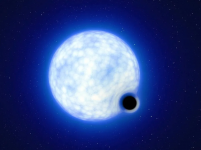
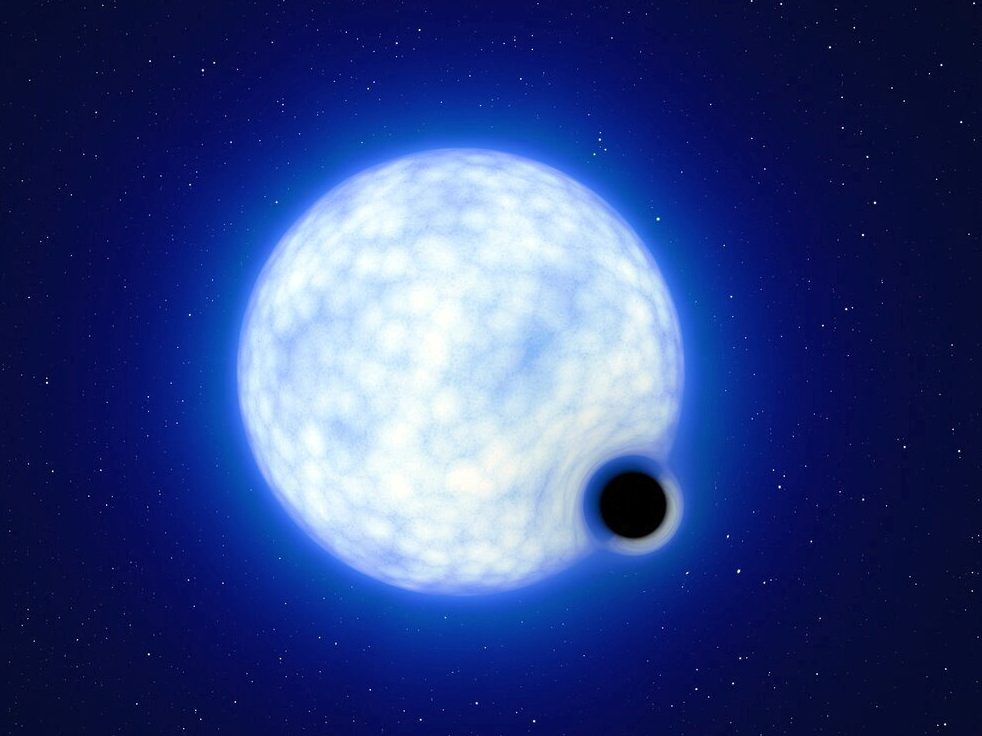
 torontosun.com
torontosun.com
Author of the article:Reuters
Reuters
Will Dunham
Publishing date:Jul 18, 2022 • 15 hours ago • 3 minute read • Join the conversation
An artist's impression showing what the binary star system VFTS 243 - containing a black hole and a large luminous star orbiting each other - might look like if we were observing it up close is seen in this undated handout image. The system, which is located in the Tarantula Nebula in the Large Magellanic Cloud galaxy, is composed of a hot, blue star with 25 times the sun's mass and a black hole, which is at least nine times the mass of the sun.
An artist's impression showing what the binary star system VFTS 243 - containing a black hole and a large luminous star orbiting each other - might look like if we were observing it up close is seen in this undated handout image. The system, which is located in the Tarantula Nebula in the Large Magellanic Cloud galaxy, is composed of a hot, blue star with 25 times the sun's mass and a black hole, which is at least nine times the mass of the sun. PHOTO BY ESO/L. CALCADA /Handout via REUTERS
WASHINGTON — Astronomers have spotted in a galaxy adjacent to our Milky Way what they are calling a cosmic “needle in a haystack” – a black hole that not only is classified as dormant but appears to have been born without the explosion of a dying star.
Researchers said on Monday this one differs from all other known black holes in that it is “X-ray quiet” – not emitting powerful X-ray radiation indicative of gobbling up nearby material with its strong gravitational pull – and that it was not born in a stellar blast called a supernova.
Black holes are extraordinarily dense objects with gravity so intense not even light can escape.
This one, with a mass at least nine times greater than our sun, was detected in the Tarantula Nebula region of the Large Magellanic Cloud galaxy and is located about 160,000 light years from Earth. A light year is the distance light travels in a year, 9.5 trillion kilometres.
An extremely luminous and hot blue star with a mass about 25 times that of the sun orbits with this black hole in a stellar marriage. This so-called binary system is named VFTS 243. The researchers believe the companion star eventually also will become a black hole and could merge with the other one.
Dormant black holes, thought to be relatively common, are hard to detect because they interact very little with their surroundings. Numerous prior proposed candidates have been debunked with further study, including by members of the team that uncovered this one.
“The challenge is finding those objects,” said Tomer Shenar, a research fellow in astronomy at Amsterdam University, lead author of the study published in the journal Nature Astronomy. “We identified a needle in a haystack.”
“It’s the first object of its kind discovered after astronomers have been searching for decades,” said astronomer and study co-author Kareem El-Badry of the Harvard & Smithsonian Center for Astrophysics.
The researchers used six years of observations from the European Southern Observatory’s Chile-based Very Large Telescope.
There are different categories of black holes. The smallest, like the newly detected one, are so-called stellar-mass black holes formed by the collapse of massive individual stars at the ends of their life cycles. There also are intermediate-mass black holes as well as the enormous supermassive black holes residing at the center of most galaxies.
“Black holes are intrinsically dark objects. They do not emit any light. Therefore, in order to detect a black hole, we usually look at binary systems in which we see one luminous star moving around a second, not-detected object,” said study co-author Julia Bodensteiner, a postdoctoral research fellow at the European Southern Observatory in Munich.
It is typically assumed that the collapse of massive stars into black holes is associated with a powerful supernova explosion. In this case, a star perhaps 20 times our sun’s mass blew some of its material into space in its death throes, then collapsed in on itself without an explosion.
The shape of its orbit with its companion offers evidence for the lack of an explosion.
“The orbit of the system is almost perfectly circular,” Shenar said.
Had a supernova occurred, the blast’s force would have kicked the newly formed black hole in a random direction and yielded an elliptical rather than circular orbit, Shenar added.
Black holes can be mercilessly ravenous, guzzling any material – gas, dust and stars – wandering within their gravitational pull.
“Black holes can only be mercilessly ravenous if there is something close enough to them that they can devour. Usually, we detect them if they are receiving material from a companion star, a process we call accretion,” Bodensteiner said.
Shenar added, “In so-called dormant black hole systems, the companion is far enough away that the material does not accumulate around the black hole to heat up and emit X-rays. Instead, it is immediately swallowed by the black hole.”


Exotic black hole deemed a 'needle in a haystack'
Astronomers have spotted in a galaxy adjacent to our Milky Way what they are calling a cosmic "needle in a haystack."
Air Force establishes new division to 'protect Canadian interests in space'
Author of the article:Canadian Press
Canadian Press
Publishing date:Jul 22, 2022 • 13 hours ago • 2 minute read • Join the conversation
OTTAWA — The Royal Canadian Air Force’s newest division is focused on extraterrestrial matters.
A reorganization of the existing space-focused team will now be known as 3 Canadian Space Division, with Brig.-Gen. Mike Adamson in command.
But if you’re picturing Armed Forces members donning space suits, think again.
“Astronauts and space exploration, this really continues to be the purview of the Canadian Space Agency,” Adamson said. “They’re looking at the science of space.”
He also said the new division is not Canada’s answer to the U.S. Space Force.
“They stood up this entire new service and they’ve got new uniforms and the whole nine yards, and a Netflix show. I’m not going to get my own Netflix show, I don’t think,” Adamson said with a laugh.
As opposed to an extension of combat power in space, Canada’s “modest” Space Division is “really just a recognition of the fact that it’s gone beyond just an office.”
He said it’s similar to the way the Air Force itself developed, when early technology during the First World War included balloon-enabled battlefield observation.
“And that turned into airplanes, and eventually somebody said, you know, I think we need an entire organization to do this whole flying thing.”
Members of Canada’s Armed Forces will be trained with specific skill sets to become space specialists.
“We’re more concerned with looking at those components of space on which we have become increasingly reliant as a society in Canada,” he said, including ATMs, internet and cellphone technology, TV and anything that relies on GPS.
Canada is part of the Combined Space Operations initiative, along with six allied countries, which released a document in February outlining its vision for the next decade.
Canada says space-based capabilities are used in communications, navigation, weather services, remote sensing, Earth observation and financial transactions, and that some countries have the ability to disrupt access to these critical functions.
Adamson said the number of satellites in Earth’s orbit has more than doubled in the last two years. It is key to have an understanding of what’s there to ensure critical infrastructure is protected.
Defence Minister Anita Anand called space a “critical domain for national security,” saying in a statement Friday the division is part of building a military that can respond to “tomorrow’s threats.”
Those threats include space junk and malicious actions by private groups or other countries, like China and Russia.
Over the next several years, the division will expand to employ about 175 people, nearly doubling the number of positions in the previous iteration, Director General Space.

 torontosun.com
torontosun.com
Author of the article:Canadian Press
Canadian Press
Publishing date:Jul 22, 2022 • 13 hours ago • 2 minute read • Join the conversation
OTTAWA — The Royal Canadian Air Force’s newest division is focused on extraterrestrial matters.
A reorganization of the existing space-focused team will now be known as 3 Canadian Space Division, with Brig.-Gen. Mike Adamson in command.
But if you’re picturing Armed Forces members donning space suits, think again.
“Astronauts and space exploration, this really continues to be the purview of the Canadian Space Agency,” Adamson said. “They’re looking at the science of space.”
He also said the new division is not Canada’s answer to the U.S. Space Force.
“They stood up this entire new service and they’ve got new uniforms and the whole nine yards, and a Netflix show. I’m not going to get my own Netflix show, I don’t think,” Adamson said with a laugh.
As opposed to an extension of combat power in space, Canada’s “modest” Space Division is “really just a recognition of the fact that it’s gone beyond just an office.”
He said it’s similar to the way the Air Force itself developed, when early technology during the First World War included balloon-enabled battlefield observation.
“And that turned into airplanes, and eventually somebody said, you know, I think we need an entire organization to do this whole flying thing.”
Members of Canada’s Armed Forces will be trained with specific skill sets to become space specialists.
“We’re more concerned with looking at those components of space on which we have become increasingly reliant as a society in Canada,” he said, including ATMs, internet and cellphone technology, TV and anything that relies on GPS.
Canada is part of the Combined Space Operations initiative, along with six allied countries, which released a document in February outlining its vision for the next decade.
Canada says space-based capabilities are used in communications, navigation, weather services, remote sensing, Earth observation and financial transactions, and that some countries have the ability to disrupt access to these critical functions.
Adamson said the number of satellites in Earth’s orbit has more than doubled in the last two years. It is key to have an understanding of what’s there to ensure critical infrastructure is protected.
Defence Minister Anita Anand called space a “critical domain for national security,” saying in a statement Friday the division is part of building a military that can respond to “tomorrow’s threats.”
Those threats include space junk and malicious actions by private groups or other countries, like China and Russia.
Over the next several years, the division will expand to employ about 175 people, nearly doubling the number of positions in the previous iteration, Director General Space.

Air Force establishes new division to 'protect Canadian interests in space'
OTTAWA — The Royal Canadian Air Force’s newest division is focused on extraterrestrial matters.
Surprise Asteroid Mystery Unraveled – Barreling Toward Earth From Blind Spot
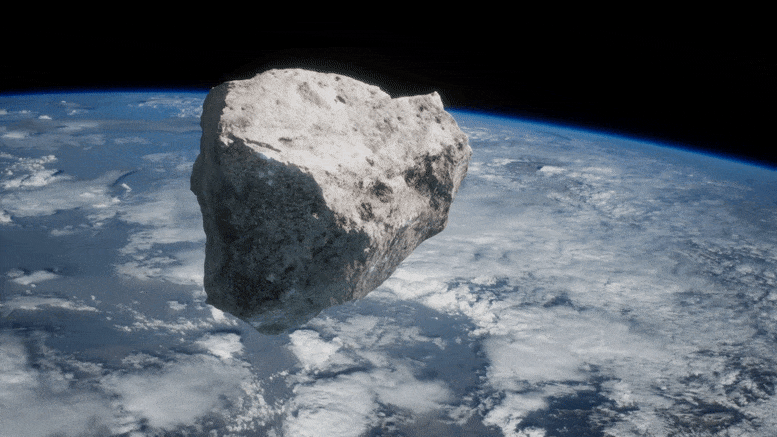
Surprise Asteroid Mystery Unraveled – Barreling Toward Earth From Blind Spot
Sudden Discovery of Asteroid 2019 OK When asteroid 2019 OK suddenly appeared barreling toward Earth on July 25, 2019, Luisa Fernanda Zambrano-Marin and the team of astronomers at the Arecibo Observatory in Puerto Rico quickly sprang into action. After receiving an alert, the radar scientists zon
scitechdaily.com
Surprise Asteroid Mystery Unraveled – Barreling Toward Earth From Blind Spot

Surprise Asteroid Mystery Unraveled – Barreling Toward Earth From Blind Spot
Sudden Discovery of Asteroid 2019 OK When asteroid 2019 OK suddenly appeared barreling toward Earth on July 25, 2019, Luisa Fernanda Zambrano-Marin and the team of astronomers at the Arecibo Observatory in Puerto Rico quickly sprang into action. After receiving an alert, the radar scientists zonscitechdaily.com
![BbZ[1].gif BbZ[1].gif](https://forums.canadiancontent.net/data/attachments/13/13193-1e121790b145972608f1501993bc29c7.jpg)
Canyon of fire' solar storm will slam into Earth today or tomorrow
https://www.livescience.com/canyon-of-fire-solar-storm#:~:text='Canyon%20of%20fire'%20solar%20storm%20will%20slam,into%20Earth%20today%20or%20tomorrow&text=Despite%20the%20alarming%20name%2C%20the%20storm%20is%20set%20to%20be%20mild.&text=Solar%20winds%20from%20the%20snapping,a%20weak%20G1%20geomagnetic%20storm.
Gluttonous cosmic 'black widow' is heaviest-known neutron star
Space object wildly spins at 707 times per second, has a mass about 2.35 times greater than that of our sun
Author of the article:Reuters
Reuters
Will Dunham
Publishing date:Jul 29, 2022 • 21 hours ago • 3 minute read • Join the conversation
A spinning neutron star periodically swings its radio (green) and gamma-ray (magenta) beams past Earth in this artist's concept of a black widow pulsar. The pulsar heats the facing side of its stellar partner to temperatures twice as hot as the sun's surface and slowly evaporates it.
A spinning neutron star periodically swings its radio (green) and gamma-ray (magenta) beams past Earth in this artist's concept of a black widow pulsar. The pulsar heats the facing side of its stellar partner to temperatures twice as hot as the sun's surface and slowly evaporates it. PHOTO BY NASA / GODDARD SPACE FLIGHT CENTER / HANDOUT /REUTERS
WASHINGTON — Astronomers have observed the most massive known example of an object called a neutron star, one classified as a “black widow” that got particularly hefty by gobbling up most of the mass of a stellar companion trapped in an unhappy cosmic marriage.
The researchers said the neutron star, wildly spinning at 707 times per second, has a mass about 2.35 times greater than that of our sun, putting it perhaps at the maximum possible mass for such objects before they would collapse to form a black hole.
A neutron star is the compact collapsed core of a massive star that exploded as a supernova at the end of its life cycle. The one described by the researchers is a highly magnetized type of neutron star called a pulsar that unleashes beams of electromagnetic radiation from its poles. As it spins, these beams appear from the perspective of an observer on Earth to pulse – akin to a lighthouse’s rotating light.
Only one other neutron star is known to spin more quickly than this one.
“The heavier the neutron star, the denser the material in its core,” said Roger Romani, director of Stanford University’s Center for Space Science and Astrophysics and a co-author of the research published this week in the Astrophysical Journal Letters.
“So as the heaviest neutron star known, this object presents the densest material in the observable universe. If it was any heavier it should collapse to a black hole, and then the stuff inside would be behind the event horizon, forever sealed off from any observation,” Romani added.
A black hole’s event horizon is the point of no return beyond which anything including light gets sucked in irretrievably.
“Since we don’t yet know how matter works at these densities, the existence of this neutron star is an important probe of these physical extremes,” Romani said.
The neutron star, residing in our Milky Way galaxy in the direction of the constellation Sextans and formally named PSR J0952-0607, is located roughly 20,000 light years from Earth, Romani said. A light year is the distance light travels in a year, 5.9 trillion miles (9.5 trillion km). The researchers studied it using the Keck I telescope in Hawaii.
Stars that are about eight or more times the sun’s mass transform hydrogen into heavier elements through thermonuclear fusion in their cores. When they build up about 1.4 times the mass of our sun in iron, that core collapses into a neutron star having a diameter only about the size of a city, with the rest blown off in the supernova explosion.
This neutron star inhabits what is called a binary system, in an orbit with another star. The neutron star is a kind dubbed a “black widow,” named in honour of female black widow spiders that eat their male partners after mating.
It apparently was born with the usual mass of a neutron star, about 1.4 times that of our sun, but its gravitational pull poached material from its companion star, enabling it to grow to a mass seemingly at the uppermost limit before physics would dictate a collapse into a black hole, the densest of all known objects.
Its companion star has been stripped almost bare, losing perhaps 98% of its mass to the black widow, leaving it at about 20 times the mass of our solar system’s largest planet Jupiter – a far cry for its original size.
“In a case of cosmic ingratitude, the black widow pulsar, which has devoured a large part of its mate, now heats and evaporates the companion down to planetary masses and perhaps complete annihilation,” added study co-author Alex Filippenko, a University of California, Berkeley, astronomy professor.
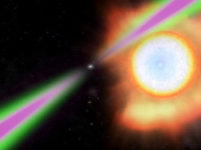
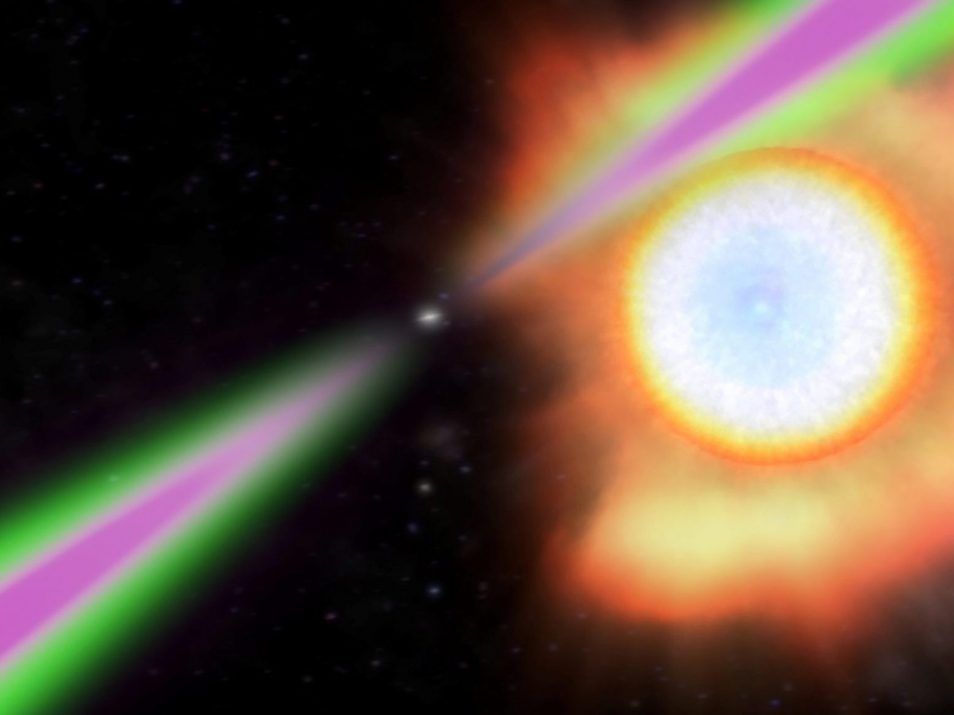
 torontosun.com
torontosun.com
Space object wildly spins at 707 times per second, has a mass about 2.35 times greater than that of our sun
Author of the article:Reuters
Reuters
Will Dunham
Publishing date:Jul 29, 2022 • 21 hours ago • 3 minute read • Join the conversation
A spinning neutron star periodically swings its radio (green) and gamma-ray (magenta) beams past Earth in this artist's concept of a black widow pulsar. The pulsar heats the facing side of its stellar partner to temperatures twice as hot as the sun's surface and slowly evaporates it.
A spinning neutron star periodically swings its radio (green) and gamma-ray (magenta) beams past Earth in this artist's concept of a black widow pulsar. The pulsar heats the facing side of its stellar partner to temperatures twice as hot as the sun's surface and slowly evaporates it. PHOTO BY NASA / GODDARD SPACE FLIGHT CENTER / HANDOUT /REUTERS
WASHINGTON — Astronomers have observed the most massive known example of an object called a neutron star, one classified as a “black widow” that got particularly hefty by gobbling up most of the mass of a stellar companion trapped in an unhappy cosmic marriage.
The researchers said the neutron star, wildly spinning at 707 times per second, has a mass about 2.35 times greater than that of our sun, putting it perhaps at the maximum possible mass for such objects before they would collapse to form a black hole.
A neutron star is the compact collapsed core of a massive star that exploded as a supernova at the end of its life cycle. The one described by the researchers is a highly magnetized type of neutron star called a pulsar that unleashes beams of electromagnetic radiation from its poles. As it spins, these beams appear from the perspective of an observer on Earth to pulse – akin to a lighthouse’s rotating light.
Only one other neutron star is known to spin more quickly than this one.
“The heavier the neutron star, the denser the material in its core,” said Roger Romani, director of Stanford University’s Center for Space Science and Astrophysics and a co-author of the research published this week in the Astrophysical Journal Letters.
“So as the heaviest neutron star known, this object presents the densest material in the observable universe. If it was any heavier it should collapse to a black hole, and then the stuff inside would be behind the event horizon, forever sealed off from any observation,” Romani added.
A black hole’s event horizon is the point of no return beyond which anything including light gets sucked in irretrievably.
“Since we don’t yet know how matter works at these densities, the existence of this neutron star is an important probe of these physical extremes,” Romani said.
The neutron star, residing in our Milky Way galaxy in the direction of the constellation Sextans and formally named PSR J0952-0607, is located roughly 20,000 light years from Earth, Romani said. A light year is the distance light travels in a year, 5.9 trillion miles (9.5 trillion km). The researchers studied it using the Keck I telescope in Hawaii.
Stars that are about eight or more times the sun’s mass transform hydrogen into heavier elements through thermonuclear fusion in their cores. When they build up about 1.4 times the mass of our sun in iron, that core collapses into a neutron star having a diameter only about the size of a city, with the rest blown off in the supernova explosion.
This neutron star inhabits what is called a binary system, in an orbit with another star. The neutron star is a kind dubbed a “black widow,” named in honour of female black widow spiders that eat their male partners after mating.
It apparently was born with the usual mass of a neutron star, about 1.4 times that of our sun, but its gravitational pull poached material from its companion star, enabling it to grow to a mass seemingly at the uppermost limit before physics would dictate a collapse into a black hole, the densest of all known objects.
Its companion star has been stripped almost bare, losing perhaps 98% of its mass to the black widow, leaving it at about 20 times the mass of our solar system’s largest planet Jupiter – a far cry for its original size.
“In a case of cosmic ingratitude, the black widow pulsar, which has devoured a large part of its mate, now heats and evaporates the companion down to planetary masses and perhaps complete annihilation,” added study co-author Alex Filippenko, a University of California, Berkeley, astronomy professor.


Gluttonous cosmic 'black widow' is heaviest-known neutron star
Astronomers have observed the most massive known example of an object called a neutron star.
Webb captures stellar gymnastics in the Cartwheel Galaxy

Webb has peered into the chaos of the Cartwheel Galaxy, revealing new details about star formation and the galaxy’s central black hole. Webb’s powerful infrared gaze produced this detailed image of the Cartwheel and two smaller companion galaxies against a backdrop of many other galaxies. This image provides a new view of how the Cartwheel Galaxy has changed over billions of years.
The Cartwheel Galaxy, located about 500 million light-years away in the Sculptor constellation, is a rare sight. Its appearance, much like that of the wheel of a wagon, is the result of an intense event – a high-speed collision between a large spiral galaxy and a smaller galaxy not visible in this image. Collisions of galactic proportions cause a cascade of different, smaller events between the galaxies involved; the Cartwheel is no exception.
The collision most notably affected the galaxy’s shape and structure. The Cartwheel Galaxy sports two rings — a bright inner ring and a surrounding, colourful ring. These two rings expand outwards from the centre of the collision, like ripples in a pond after a stone is tossed into it. Because of these distinctive features, astronomers call this a “ring galaxy,” a structure less common than spiral galaxies like our Milky Way.
The galaxy’s bright core hosts an active galactic nucleus, which is a supermassive black hole surrounded by a tremendous amount of gas and hot dust. The brightest areas host populations of older stars, while the outer ring, which has expanded for about 440 million years, is dominated by new star formation and supernovae. As this ring expands, it ploughs into surrounding gas and triggers star formation.
Other telescopes, including the NASA/ESA Hubble Space Telescope, have previously examined the Cartwheel. But the dramatic galaxy has been shrouded in mystery – perhaps literally, given the amount of dust that obscures the view. Webb, with its ability to detect infrared light, now uncovers new insights into the nature of the Cartwheel.
The Near-Infrared Camera (NIRCam), Webb’s primary imager, looks in the near-infrared range from 0.6 to 5 microns, seeing crucial wavelengths of light that can reveal even more stars than observed in visible light. This is because young stars, many of which are forming in the outer ring, are less obscured by the presence of dust when observed in infrared light. In this image, NIRCam data are coloured blue, orange, and yellow. The galaxy displays many individual blue dots, which are individual stars or pockets of star formation. NIRCam also reveals the difference between the smooth distribution or shape of the older star populations and dense dust in the core compared to the clumpy shapes associated with the younger star populations outside of it.
 Cartwheel Galaxy (MIRI)
Cartwheel Galaxy (MIRI)
Learning finer details about the dust that inhabits the galaxy, however, requires Webb’s Mid-Infrared Instrument (MIRI). MIRI data are coloured red in this composite image. It reveals regions within the Cartwheel Galaxy rich in hydrocarbons and other chemical compounds, as well as silica dust, like much of the dust on Earth. These regions form a series of spiralling spokes that essentially form the galaxy’s skeleton. These spokes are evident in previous Hubble observations released in 2018, but they become much more prominent in this Webb image.
Webb’s observations underscore that the Cartwheel is in a very transitory stage. The galaxy, which was presumably a normal spiral galaxy like the Milky Way before its collision, will continue to transform. While Webb gives us a snapshot of the current state of the Cartwheel, it also provides insight into what happened to this galaxy in the past and how it will evolve in the future.
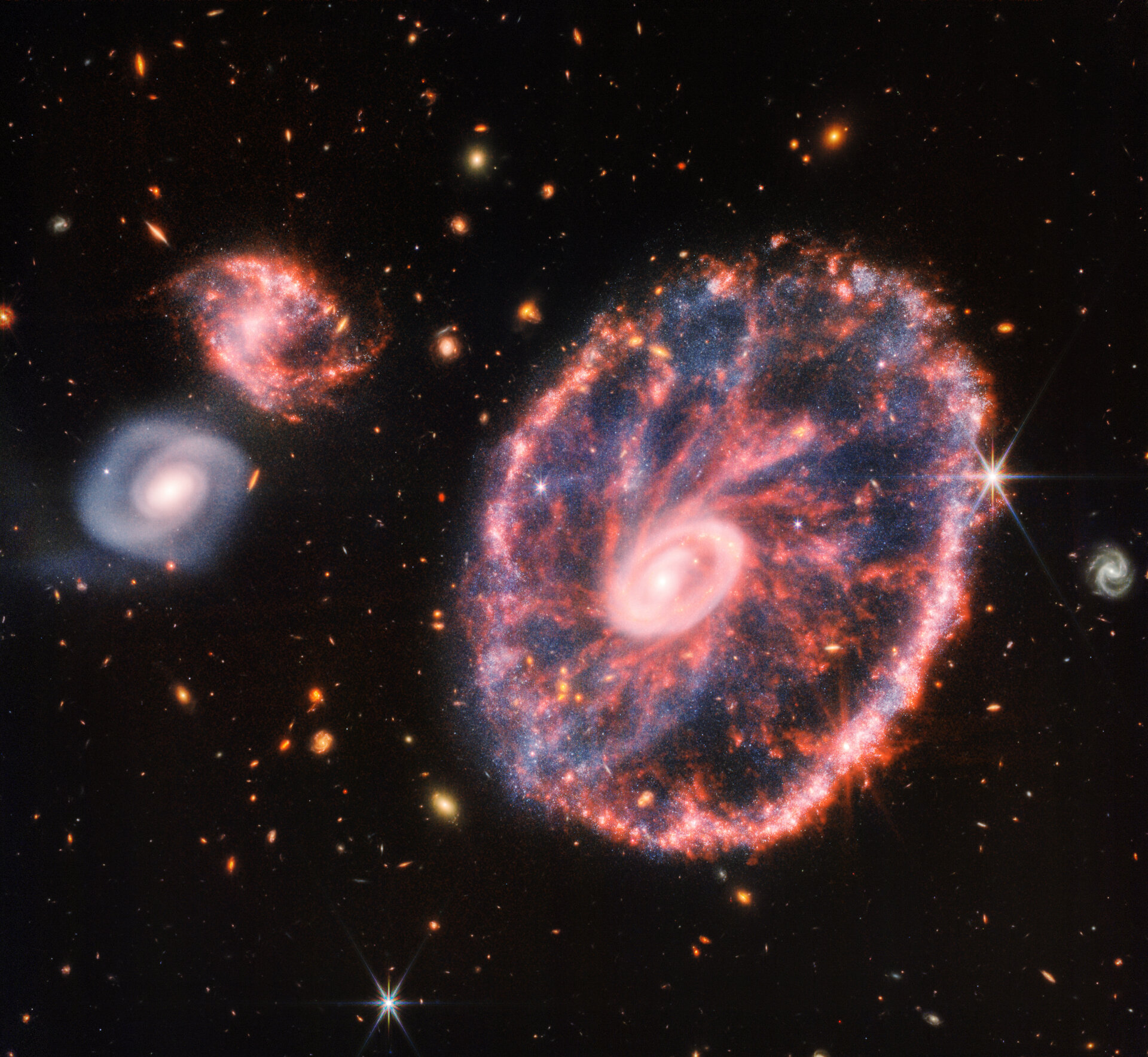
Webb captures stellar gymnastics in the Cartwheel Galaxy
The Cartwheel Galaxy, a rare ring galaxy once shrouded in dust and mystery, has been unveiled by the imaging capabilities of the NASA/ESA/CSA James Webb Space Telescope. The galaxy, which formed as a result of a collision between a large spiral galaxy and another smaller galaxy, not only...
www.esa.int
Conspiracy theorists say they have new proof Apollo 17 moon landing was hoax
Author of the article ostmedia News
ostmedia News
Publishing date:Aug 17, 2022 • 9 hours ago • 2 minute read • 14 Comments
Conspiracy theorists claim they have new proof that the Apollo 17 moon landing was a hoax by the U.S. government. Claims that the moon landings were a hoax have been around since 1969, but a new one focuses on an odd figure found in the visor of one of the astronauts in a clip of the 1972 Apollo 17 mission.
Conspiracy theorists claim they have new proof that the Apollo 17 moon landing was a hoax by the U.S. government. Claims that the moon landings were a hoax have been around since 1969, but a new one focuses on an odd figure found in the visor of one of the astronauts in a clip of the 1972 Apollo 17 mission. PHOTO BY SCREENGRAB /YouTube/Streetcap1
Conspiracy theorists claim they have new proof that the Apollo 17 moon landing was a hoax by the U.S. government.
Claims that the moon landings were a hoax have been around since 1969, but a new one focuses on an odd figure found in the visor of one of the astronauts in a clip of the 1972 Apollo 17 mission.
On the last manned trip to the moon, the astronauts — commander Gene Cernan, lunar module pilot Harrison “Jack” Schmitt and command module pilot Ronald Evans — were the final people to touch down.
In a video titled “Reflection in a Visor. Where’s the reflection of the camera taking the photo?” user Streetcap1 claims the shot proves it was a hoax.
The YouTuber claims a reflection in the visor of one of the astronauts shows a “stagehand” — and, allegedly, the person is not wearing a spacesuit, according to the New York Post.
“You can see some sort of, it looks like a man, back in the early ’70s, long hair, wearing some sort of waistcoat-type thing … and a shadow of that figure, presumably,” the narrator claimed, using his mouse to outline the figure as he talks.
“Where’s this guy’s space suit?” he says.
The clip has been viewed nearly three million times since being uploaded in 2017.
Some commentators tried to throw hot water on the theory.
“The curvature of the astronaut’s visor causes a fish-eye lens effect. Just Google ‘fish eye lens pics’ and you will see how distorted they are. When you look at the shadow you can clearly see the boxy shape of his life support system,” argued one user in the comments.
“To me it clearly looks like another astronaut with the white, bulky spacesuit. you can see that he has both arms slightly stretched forward and the shadow shows the bulkyness of the spacesuit, including the life support on his back,” another wrote.
Despite being widely disproven, many theorists continue to claim the moon landings were hoaxes.

 history.com
history.com

 nypost.com
nypost.com

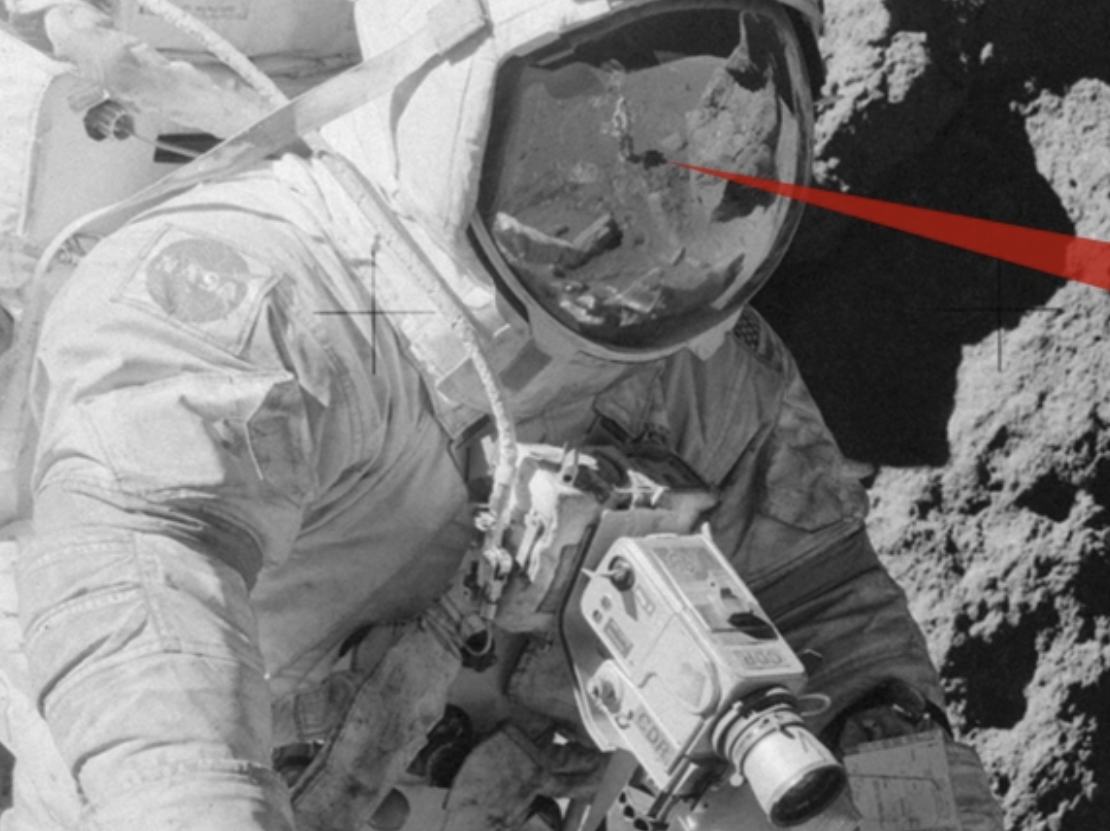
 torontosun.com
torontosun.com
Author of the article
Publishing date:Aug 17, 2022 • 9 hours ago • 2 minute read • 14 Comments
Conspiracy theorists claim they have new proof that the Apollo 17 moon landing was a hoax by the U.S. government. Claims that the moon landings were a hoax have been around since 1969, but a new one focuses on an odd figure found in the visor of one of the astronauts in a clip of the 1972 Apollo 17 mission.
Conspiracy theorists claim they have new proof that the Apollo 17 moon landing was a hoax by the U.S. government. Claims that the moon landings were a hoax have been around since 1969, but a new one focuses on an odd figure found in the visor of one of the astronauts in a clip of the 1972 Apollo 17 mission. PHOTO BY SCREENGRAB /YouTube/Streetcap1
Conspiracy theorists claim they have new proof that the Apollo 17 moon landing was a hoax by the U.S. government.
Claims that the moon landings were a hoax have been around since 1969, but a new one focuses on an odd figure found in the visor of one of the astronauts in a clip of the 1972 Apollo 17 mission.
On the last manned trip to the moon, the astronauts — commander Gene Cernan, lunar module pilot Harrison “Jack” Schmitt and command module pilot Ronald Evans — were the final people to touch down.
In a video titled “Reflection in a Visor. Where’s the reflection of the camera taking the photo?” user Streetcap1 claims the shot proves it was a hoax.
The YouTuber claims a reflection in the visor of one of the astronauts shows a “stagehand” — and, allegedly, the person is not wearing a spacesuit, according to the New York Post.
“You can see some sort of, it looks like a man, back in the early ’70s, long hair, wearing some sort of waistcoat-type thing … and a shadow of that figure, presumably,” the narrator claimed, using his mouse to outline the figure as he talks.
“Where’s this guy’s space suit?” he says.
The clip has been viewed nearly three million times since being uploaded in 2017.
Some commentators tried to throw hot water on the theory.
“The curvature of the astronaut’s visor causes a fish-eye lens effect. Just Google ‘fish eye lens pics’ and you will see how distorted they are. When you look at the shadow you can clearly see the boxy shape of his life support system,” argued one user in the comments.
“To me it clearly looks like another astronaut with the white, bulky spacesuit. you can see that he has both arms slightly stretched forward and the shadow shows the bulkyness of the spacesuit, including the life support on his back,” another wrote.
Despite being widely disproven, many theorists continue to claim the moon landings were hoaxes.

The Wildest Apollo 11 Moon Landing Conspiracy Theories, Debunked | HISTORY
Claims the Apollo 11 mission was staged began soon after astronauts first set foot on the moon in 1969.

Moon landing conspiracy theorists say this photo is new ‘hoax’ proof
“You can see some sort of, it looks like a man, back in the early 70s, long hair, wearing some sort of waistcoat-type thing,” one doubter claims.


Conspiracy theorists say they have new proof Apollo 17 moon landing was hoax
Conspiracy theorists claim they have new proof that the Apollo 17 moon landing was a hoax by the U.S. government.

